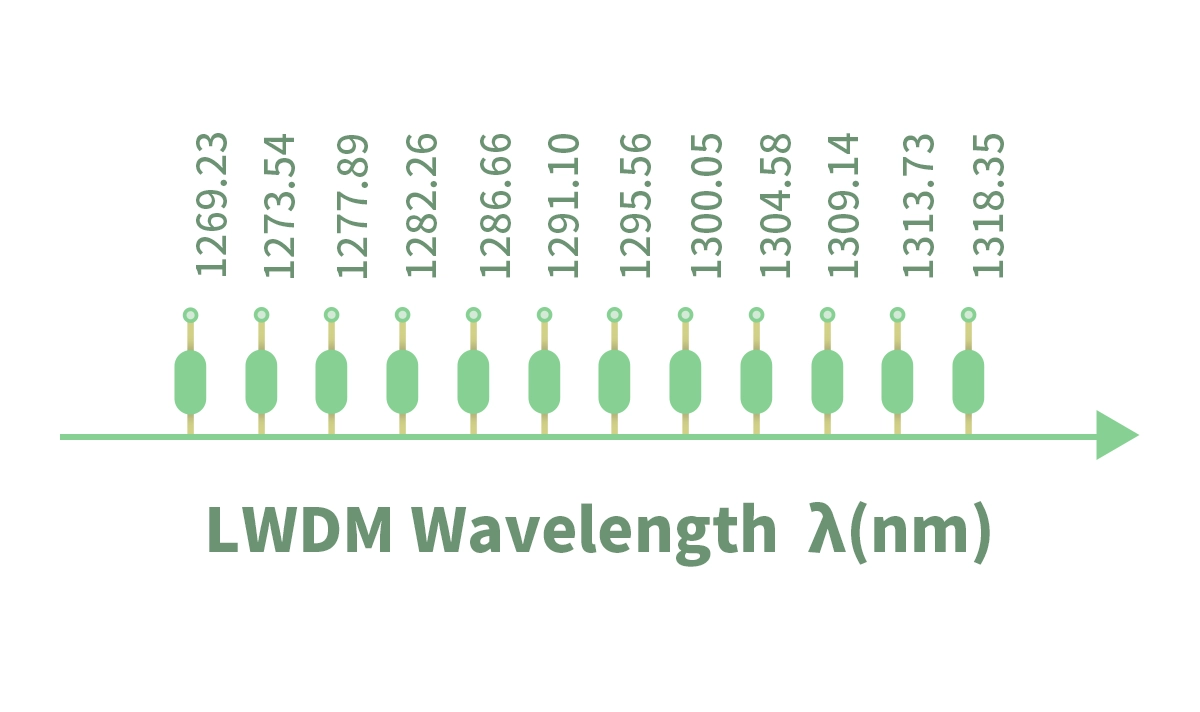
In the relentless pursuit of higher bandwidth and greater network density, innovative optical technologies constantly emerge. One such technology gaining significant traction is LWDM (LAN Wavelength Division Multiplexing). If you're involved in network planning, data center operations, or telecommunications, understanding LWDM is becoming increasingly crucial. This guide dives deep into what LWDM technology is, how it works, its advantages, and where it shines.
➤ Key Takeaways
LWDM sends more data by using different light wavelengths on one fiber. This helps LANs get faster and have more bandwidth. It works best for short distances, up to 40 km. It uses the O-band for clear and steady signals. This also helps keep costs low. LWDM is a good choice for LANs and data centers. It lets companies make networks better without new cables. LWDM is easier and cheaper than CWDM and DWDM for local networks. It gives a good mix of speed, price, and ease. LWDM helps 5G, cloud, and smart devices grow fast. It does this by giving high data rates and easy setup.
➤ Understanding the Core: Wavelength Division Multiplexing (WDM)
To grasp LWDM, we must start with its foundation: Wavelength Division Multiplexing (WDM). WDM is the fundamental technique that allows multiple optical signals, each carried on a distinct wavelength (or color) of laser light, to be transmitted simultaneously over a single optical fiber. This dramatically multiplies the fiber's capacity without laying new cables. The two most established WDM types are:
CWDM (Coarse Wavelength Division Multiplexing): Uses wider channel spacing (typically 20nm), operating in the 1270nm to 1610nm range. Simpler and cheaper optics, but supports fewer channels (usually up to 18).
DWDM (Dense Wavelength Division Multiplexing): Uses very tight channel spacing (e.g., 0.8nm, 0.4nm), primarily in the C-band (~1530nm to 1565nm) and L-band. Supports a high number of channels (80+), enabling massive capacity over long distances. Requires more complex and expensive optics.
➤ Where Does LWDM Fit In? Defining the Technology
LWDM is short of LAN WDM (Local Area Network Wavelength Division Multiplexing) is a specialized WDM technology designed to bridge the gap between CWDM and DWDM, specifically optimized for cost-effective, high-density connectivity within shorter reach applications, typically within data centers and enterprise campus networks.
Its key defining characteristic is its operational wavelength grid. While CWDM uses wavelengths spread across the O, E, S, C, and L bands, and DWDM concentrates densely in the C/L bands, LWDM strategically utilizes specific wavelengths primarily within the O-band (1260nm to 1360nm), leveraging the lower chromatic dispersion characteristics of this band.
The LWDM Wavelength Grid: Precision for Performance

LWDM employs a defined set of wavelengths with a channel spacing of 4nm. The most common LWDM grid, standardized by IEEE for specific applications, utilizes 12 wavelengths:
LWDM Channel | Wavelength (nm) | LWDM Channel | Wavelength (nm) |
|---|---|---|---|
Channel 1 | 1269.23 | Channel 7 | 1295.56 |
Channel 2 | 1273.54 | Channel 8 | 1300.05 |
Channel 3 | 1277.89 | Channel 9 | 1304.58 |
Channel 4 | 1282.26 | Channel 10 | 1309.14 |
Channel 5 | 1286.66 | Channel 11 | 1313.73 |
Channel 6 | 1291.10 | Channel 12 | 1318.35 |
*Table 1: Standardized 12-Channel LWDM Wavelength Grid (based on IEEE 802.3cn).*
This specific grid within the O-band allows LWDM to deliver significant advantages for its target applications.
➤ Why Choose LWDM? Key Advantages
LWDM technology offers a compelling set of benefits, particularly in high-density, cost-sensitive, and power-constrained environments:
Reduced Chromatic Dispersion (CD): Operating in the O-band significantly lowers chromatic dispersion compared to the C-band used by many DWDM systems. This allows for simpler, cheaper transceivers without complex dispersion compensation modules (DCMs), especially beneficial for reaches up to 10km.
Cost-Effectiveness: Compared to full DWDM systems, LWDM transceivers (LWDM optical transceivers) are generally less complex and utilize uncooled lasers similar to CWDM, leading to lower module costs and reduced operational expenses.
High Density: The 4nm channel spacing enables packing 12 or more channels onto a single fiber pair within a compact spectrum. This translates to a high port density on aggregation switches or routers, maximizing rack space utilization – a critical factor in modern data centers.
Optimized for Short Reach: LWDM excels precisely in the 2km to 10km range common for data center interconnects (DCI) between buildings or within large campuses, and for connecting top-of-rack (ToR) switches to aggregation layers.
Simplified Deployment: Avoiding the need for dispersion compensation and often using uncooled lasers simplifies system design, installation, and maintenance compared to long-haul DWDM.
➤ LWDM vs. CWDM vs. DWDM: Choosing the Right Tool
Feature | CWDM | LWDM | DWDM |
|---|---|---|---|
Channel Spacing | 20nm | 4nm | 0.8nm, 0.4nm, etc. |
Typical Channels | Up to 18 | 8, 12, 24 | 40, 80, 96+ |
Primary Band | O, E, S, C, L | O-band (1260-1360nm) | C-band, L-band |
Reach Focus | <~80km | 2km - 40km | 80km - 1000s km |
Transceiver Cost | Lowest | Moderate | Highest |
Dispersion Comp. | Seldom needed | Seldom needed | Often Required |
Laser Type | Uncooled | Uncooled | Cooled (often) |
Best Suited For | Cost-sensitive, low-density, short-mid reach | High-density DCIs, campus links, aggregation (2-40km) | Long-haul, ultra-high capacity |
Table 2: Comparing CWDM, LWDM, and DWDM Characteristics.
➤ Key Applications for LWDM Technology
LWDM finds its strongest use cases where high port density, cost efficiency, and reach up to 40km are paramount:
Data Center Interconnects (DCI): Connecting multiple data center buildings within a campus or metropolitan area (typically 2km to 10km). LWDM's density allows massive bandwidth scaling over existing fiber pairs.
High-Density Aggregation: Connecting numerous Top-of-Rack (ToR) switches to aggregation or core switches within a single large data center hall. LWDM maximizes fiber utilization without needing complex DWDM systems.
5G Fronthaul: Providing high-capacity, low-latency connections between centralized units (CU), distributed units (DU), and remote radio units (RRU) in 5G mobile networks, especially for distances under 10km.
Enterprise Campus Networks: Connecting buildings across large corporate or university campuses requiring more bandwidth than CWDM offers but where DWDM is overkill and too expensive.
Cost-Effective Bandwidth Expansion: When facing fiber exhaust, LWDM provides a scalable and economical upgrade path compared to laying new fiber or deploying full DWDM.
➤ Implementing LWDM: Components and Considerations
A basic LWDM link requires:
LWDM Transceivers: Installed in switches/routers at each end. These are LWDM optical modules (e.g., SFP28, QSFP28, QSFP-DD, OSFP) tuned to specific LWDM wavelengths. For example, LINK-PP offers high-performance LWDM transceivers like the LQ-LW100-LR4C (1295.56nm to 1309.14nm variants) and the LQ-LW100-ZR4C for next-gen 100G applications.
LWDM Mux/Demux (Multiplexer/Demultiplexer): Passive optical components that combine (multiplex) the different wavelength signals onto a single fiber at the transmitting end and separate (demultiplex) them back into individual wavelengths at the receiving end. These come in channel counts like 8, 12, or 24.
Single-Mode Fiber (SMF): Standard G.652.D fiber is used.
Choosing reliable, high-quality LWDM transceivers and passive components is essential for optimal performance and network stability. Partnering with established manufacturers like LINK-PP ensures compatibility, performance, and longevity for your high-density LWDM solutions.
➤ The Future of LWDM: Scaling with Demand
As data center traffic continues its explosive growth and technologies like 400G and 800G Ethernet become mainstream, LWDM is evolving. We see:
Higher Channel Counts: Moving beyond 12 channels (e.g., 24 channels) to support even greater density.
Support for Higher Speeds: LWDM optical transceivers are already enabling 100G per wavelength (using PAM4 modulation in QSFP28/QSFP-DD/OSFP form factors) and will scale to 200G and beyond.
Co-existence with Other Technologies: LWDM can be combined with techniques like BiDi (Bidirectional) transmission over a single fiber or used alongside CWDM channels on different bands to maximize fiber capacity even further.
➤ Unlock Higher Density and Cost Efficiency with LINK-PP LWDM Solutions

LWDM technology has firmly established itself as the optimal solution for high-bandwidth, high-density connectivity over short to medium distances. Its clever use of the O-band wavelength grid delivers the crucial balance of performance, density, and cost that modern data centers and 5G networks desperately need. By offering a significant capacity boost over CWDM without the complexity and expense of long-haul DWDM, LWDM solves critical fiber exhaust challenges efficiently.
Ready to explore how LWDM can transform your network's capacity and efficiency?
Discover LINK-PP's comprehensive range of high-performance, reliable LWDM optical transceivers, including specific models like the LQ-LW100-ER4C, designed for seamless integration and optimal performance in demanding environments. Our professional optical transceiver solutions are engineered to meet rigorous standards for data center interconnects, 5G fronthaul, and enterprise network upgrades.
➤ FAQ
Q: What is the main difference between LWDM and CWDM?
A: LWDM puts channels closer together in the O-band. CWDM has channels farther apart and uses more wavelengths. LWDM is good for local networks and data centers. CWDM works best for metro and access networks.
Q: How does LWDM improve LAN connectivity?
A: LWDM lets a LAN send data on many wavelengths using one fiber. This gives more bandwidth and helps more people use the network. Businesses can upgrade without putting in new cables.
Q: Can LWDM support 5G networks?
A: LWDM helps 5G by giving high bandwidth and steady signals. Many 5G networks use LWDM for front haul links. This tech moves lots of data fast and works well.
Q: Why do data centers use LWDM for inter-connects?
A: Data centers pick LWDM to send data fast over short spaces. LWDM modules can do 100G, 200G, or 400G speeds. This is great for linking switches and servers in new data centers.
Q: Is LWDM compatible with standard single-mode fiber?
A: LWDM works with normal single-mode fiber. It does not need special cables. This makes it easy to use in old LANs and saves money on upgrades.
See Also
Exploring WDM Technology And Its Uses In Optical Networks
The Importance Of Digital Monitoring In Optical Transceivers
An Introduction To Distributed Feedback Lasers Explained Clearly


